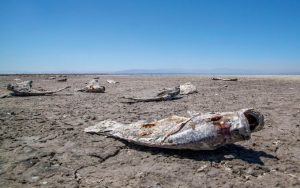copyright 2018 David Bacon

Paola was standing outside the West County Detention Facility, a prison in Richmond, California for 150 to 300 people awaiting deportation, when she got the phone call. She’d been fearing it for days. Florencio, her husband, was in another detention center in Arizona, calling to tell her that la migra (immigration agents) had caught him in the desert, walking north with a dozen others.
Paola (not her real name) hadn’t spoken to Florencio for several weeks, not since the day before he crawled into the luggage compartment of a bus in Puebla in southern Mexico. The bus, he hoped, would take him close to the U.S. border.
It had already been a harrowing journey for himself and Paola’s brother Lorenzo. “After we left Guatemala and crossed the river into Mexico, we wound up in a kind of camp in Chiapas,” Florencio recalls. “There were hundreds of people there.” When the day to leave on the long trip north finally arrived, the coyotes running the camp organized a kind of shape up. It was not that different from the stories told by an earlier generation of migrants, the braceros (contract farm laborers), who remember being herded together at Mexican way stations, inspected and shipped to the border between 1942 and 1964.
…


